
The new American Experience documentary THE CODEBREAKER, supported by the Alfred P. Sloan Foundation, tells the story of Elizebeth Friedman’s groundbreaking career as one of the first professional codebreakers and originator of strategic intelligence in the U.S. Based on the book The Woman Who Smashed Codes: A True Story of Love, Spies, and the Unlikely Heroine Who Outwitted America's Enemies, by Jason Fagone who is also featured in the documentary, THE CODEBREAKER is written, directed, and produced by Chana Gazit. It premiered on PBS on January 11 and is available to stream on PBS.org.
Elizebeth Friedman, née Smith, was born into a Quaker family in Indiana and got her start as a cryptologist when she was recruited in 1916 by millionaire George Fabyan. He brought her to work at his newly established Riverbank Laboratory in Illinois. She was tasked with pursuing Fabyan's theory that Francis Bacon was the true author of Shakespeare and had encrypted the text with secret messages. Elizebeth partnered with fellow resident William Friedman, who was taking close-up photographs of the text, and the two ultimately found the theory to be unsubstantiated. Their method of cryptoanalysis, however, proved useful as World War I was beginning and wireless radio, used as a form of communication, could be easily intercepted.
Elizebeth and her now husband William became the core of the codebreaking unit tasked by the U.S. to decipher enemy codes during World War I. After the war, William continued to serve in the Army which did not allow women, so Elizebeth continued her career working for the Coast Guard. There, she became head of their first codebreaking unit formed to bring down organized crime which was importing liquor during prohibition. Friedman was demoted, however, when the unit became part of the Navy and a man is put in charge. Nevertheless, Friedman had an astonishing rest of her career helping the Allies win World War II by intercepting German U-boat messages, ferreting out fascist organizers in South America, and gathering crucial intelligence all without use of the computers that are today standard for this kind of work. Having signed an oath of silence until death, Friedman’s contributions have been unknown until 2008 when they were declassified.
PARTNERS
TOPICS